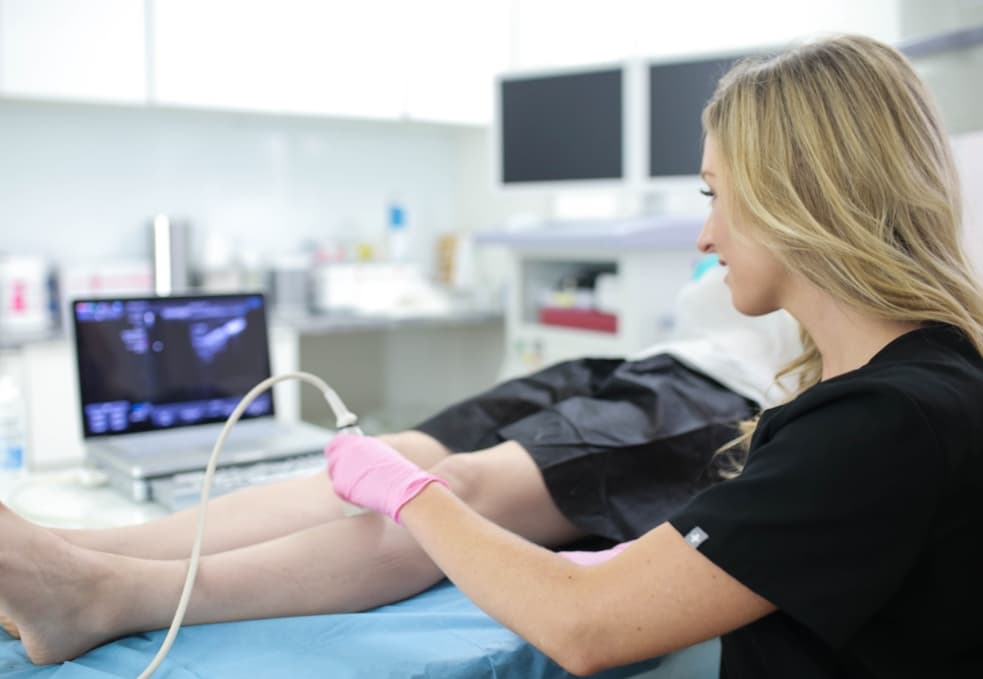Step 1: Consult a vein doctor for an evaluation
Restless leg syndrome is a condition that leads to a constant and irresistible urge to shake and move your legs. The symptoms of restless leg syndrome usually worsen at the end of the day or after long periods of sitting or standing still. You may suffer from restless leg syndrome for numerous underlying factors. But if the symptoms worsen at night or if you also have other symptoms, such as leg swelling, leg heaviness, and leg cramps, you may have chronic venous insufficiency, a circulatory disorder that leads to inadequate blood circulation.
Chronic venous insufficiency is a medical condition wherein the collapse of vein valves leads to backward blood circulation. The vein valves are responsible for ensuring smooth, one-way blood circulation to the heart. When the vein valves malfunction, blood flows backward and accumulates in the leg veins, eventually leading to the formation of dilated varicose veins and spider veins on the skin’s surface. The accumulation of blood in leg veins also leads to restless leg syndrome, especially at the end of the day.
Long Island Vein Treatment is a state-of-the-art medical center with offices in West Islip, Jericho, and Hampton Bays. If you have restless leg syndrome, we encourage you to schedule an appointment at your nearest medical center for vein treatment in Long Island. Our board-certified vein doctors will examine your leg veins, discuss your symptoms, review your medical history, and determine the root cause of your symptoms. Our vein doctors can help you determine if your symptoms of restless leg syndrome are truly caused by chronic venous insufficiency.
Step 2: Undergo an ultrasound scan
After a thorough evaluation, the vein doctor will administer an ultrasound test known as duplex ultrasound. During a duplex ultrasound, the sonographer will use a handheld device to send sonic waves into your legs, which will reveal the direction of blood flow in your leg veins on a computer screen. Your vein doctor will interpret the results of the duplex ultrasound to determine if you have underlying vein disease. And if you have vein disease, the vein doctor will identify the diseased saphenous vein responsible for your symptoms.
Step 3: Treat the root cause of restless leg syndrome
After diagnosing the root cause of restless leg syndrome, the vein doctor will curate a personalized vein treatment plan. The best way to alleviate the symptoms of RLS is to close or destroy the diseased saphenous vein. The vein doctor will offer minimally invasive procedures for restless leg syndrome, such as radiofrequency ablation, endovenous laser ablation, and venaseal. During these procedures, the vein doctor will use thermal energy, laser energy, or medical adhesives to destroy the diseased vein and reroute the accumulated blood into healthier leg veins, thus treating the root cause of restless leg syndrome.
Frequently asked questions about restless leg syndrome and vein disease
How long does laser vein treatment take to heal?
Laser vein treatment uses high-intensity light to destroy the veins. The light is selectively absorbed by the blood in the veins, which heats up and destroys the vein. After the treatment, the vein will gradually disappear. You may see some redness and swelling immediately after the treatment, but this should go away within a few hours.
Sometimes, the treated vein can become hard and lumpy. This is usually only temporary and will go away on its own. Most people can return to their normal activities right away. However, you should avoid strenuous exercise or exposure to sunlight for at least 24 hours.
Is spider vein removal safe?
Sclerotherapy is the most common treatment for spider veins. It involves injecting a solution into the veins, which causes them to collapse and eventually fade away. When performed by a qualified professional, spider vein removal is completely safe. Complications are rare but can include skin bruising, allergic reactions to the injected solutions, and blood clots.
Should I elevate my legs after sclerotherapy?
If you have just had sclerotherapy to treat your spider or varicose veins, you may be wondering if there are any special aftercare instructions you need to follow. One common question is whether you should elevate your legs after sclerotherapy.
Generally, it is recommended that you elevate your legs intermittently for at least the first 24 hours after sclerotherapy. This helps to reduce swelling and discomfort. It also helps the sclerosant to work its way into the veins so it can start to break down the vein walls.
Elevating your legs does not mean that you have to lie down all the time. You can still go about your normal activities, but you should try to avoid standing or sitting for long periods of time. If you do need to sit or stand for long periods, make sure to take a break every 30 minutes or so to walk around and get your blood flowing.
Can I get blood clots after varicose vein treatment?
Yes, it is possible to get blood clots after varicose vein treatment, but it is rare. There are several different types of varicose vein treatment, and each has a different risk of developing blood clots. Some of the more common treatments are sclerotherapy, endovenous laser treatment, and radiofrequency ablation. The risks of blood clots are low with these treatments, but they can occur.
If you are concerned about developing blood clots after varicose vein treatment, talk to your doctor about your risk factors. There are some things that can increase your risk, such as being overweight, having a history of blood clots, or having a family history of blood clots. Your doctor can help you assess your risk and decide if varicose vein treatment is right for you. Our vein doctors also take special precautions to ensure safe results.
